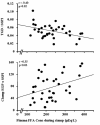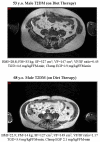Visceral fat dominant distribution in male type 2 diabetic patients is closely related to hepatic insulin resistance, irrespective of body type
- PMID: 19656356
- PMCID: PMC2729732
- DOI: 10.1186/1475-2840-8-44
Visceral fat dominant distribution in male type 2 diabetic patients is closely related to hepatic insulin resistance, irrespective of body type
Abstract
Background: All previous studies that investigated the association between abdominal fat distribution and insulin resistance evaluated subcutaneous and visceral fat area and/or volume, but these values were not related to the body type of each subject. In the present study we have examined the association between abdominal fat distribution and peripheral (muscle)/hepatic sensitivity to insulin using the visceral to abdominal subcutaneous fat area ratio (VF/SF ratio) in male patients with type 2 diabetes mellitus. This ratio defines the predominancy of visceral or subcutaneous abdominal adiposity, independent of the body type of each individual.
Methods: Thirty-six type 2 diabetic male patients underwent a euglycemic insulin clamp (insulin infusion rate = 40 mU/m2 x min) with 3-3H-glucose to measure insulin-mediated total body (primarily reflects muscle) glucose disposal (TGD) and suppression of endogenous (primarily reflects liver) glucose production (EGP) in response to a physiologic increase in plasma insulin concentration. Abdominal subcutaneous (SF) and intraabdominal visceral fat (VF) areas were quantitated with magnetic resonance imaging (MRI) at the level of L4-5.
Results: TGD and TGD divided by steady state plasma insulin concentration during the insulin clamp (TGD/SSPI) correlated inversely with body mass index (BMI), total fat mass (FM) measured by 3H2O, SF and VF areas, while VF/SF ratio displayed no significant relationship with TGD or TGD/SSPI. In contrast, EGP and the product of EGP and SSPI during the insulin clamp (an index hepatic insulin resistance) correlated positively with VF/SF ratio, but not with BMI, FM, VF or SF.
Conclusion: We conclude that, independent of the individual's body type, visceral fat dominant accumulation as opposed to subcutaneous fat accumulation is associated with hepatic insulin resistance, whereas peripheral (muscle) insulin resistance is more closely related to general obesity (i.e. higher BMI and total FM, and increased abdominal SF and VF) in male patients with type 2 diabetes.
Figures



References
-
- DeFronzo RA. Pathogenesis for type 2 diabetes: metabolic and molecular implications for identifying diabetes genes. Diabetes Rev. 1997;4:177–269.
-
- Diehl AK, Stern MP. Social health problems of Mexican-American: obesity, gallbladder disease, diabetes mellitus, and cardiovascular disease. Adv Intern Med. 1989;34:73–96. - PubMed
Publication types
MeSH terms
Substances
Grants and funding
LinkOut - more resources
Full Text Sources
Medical
Research Materials

